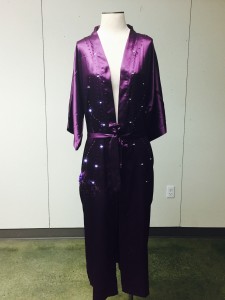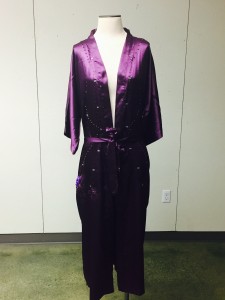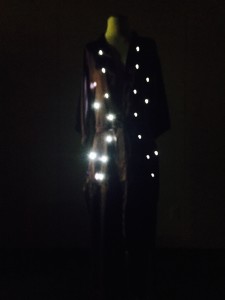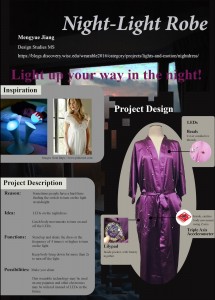Description: This project is a robe containing LEDs that can light up. People can use it during the midnight to light up their way instead of finding the switch to turn on the light. There are Lilypad and a battery hidden in the side pocket. This robe uses the Z axis of a triple axis accelerometer board to capture the body movement. When people get up and stand straightly, the board is at a vertical position and the output of the Z axis is around 500. When people shake this robe, there will be some changes in the Z axis and the out put will be sometimes more than 550 or less than 450. If the output reaches both these two numbers (550, 450) twice in a certain period of time, 20 LEDs on the robe will all light up and keep lighting. When people go to bed again and lie down for more than 2 seconds which means the board is at a horizontal position and the output of Z axis is under 400, 20 LEDs will light off. All the conductive threads used are covered with beads at the outside.
Self-evaluation: Overall, I feel happy about this project because it works which is an achievement for me. I think I did well for most of the parts such as coding, designing and sewing. The code is not that complicated but it works efficiently and most of the conductive threads are covered beautifully which created a good-looking pattern on the robe. But there are still some that I’m not very satisfied with. For example, the threads inside are covered with electricity-resistant tape which is useful but not well finished. Since the design of the circuit is hard to achieve, most of the LEDs are in a series circuits so the light is not bright enough. Moreover, the battery may need to be more powerful. To sum up, I think my robe meets my goals in the function requirement but need to be improved in the workmanship requirement.
Hurdles and solutions: During the whole process, I had three main hurdles. First was to make my circuit both functional and good-looking. Since the pins on Lilypad has a certain order and the positive and negative threads cannot be touched so I had a hard time designing my circuit. I divided the 20 LEDs to two routes, 14 in one and 6 in the other. The two routes both start from pins on Lilypad and connect the positive side of the LEDs. Then I embedded a third route which is only connected to the negative side of the Lilypad and all the negative sides of 20 LEDs are connected to the third route. Second was to sew them perfectly. In fact, there are still some threads uncovered which are near the pocket. This is because the part of the Lilypad hidden in the pocket was hard and I could not make sure my decorations would not influence the effect. And the sewing for the entire routes was time-consuming and exhausting due to the fact that there are so many LEDs in different circuit and I had to keep space between the positive and negative. The third was to adjust the code after finishing sewing. Since I had to test on it to see how the output of my board would change when I was shaking the robe, I adjusted it so many times and not every time the shaking-lighting function succeeded. I had to pay special attention to the way I shook.
Possible Improvement: If I had more time, I would like to cover the threads inside with some similar fabric and I would use more parallel than series to make the light brighter. Moreover, I would choose a more powerful battery.



